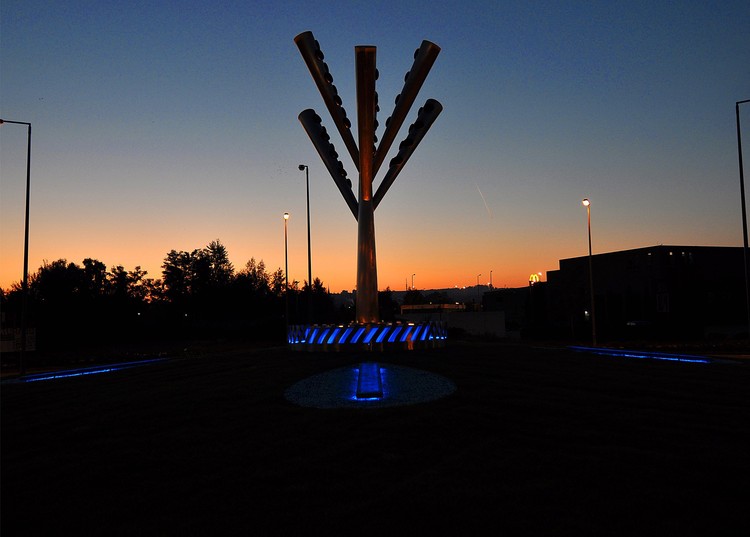
To celebrate the 150 year anniversary of the Utility and Amenities Company of the city of Zweibrücken, Germany, the company decided to donate a roundabout to the city which was to deal with the present and the future of Zweibrücken and the company itself. Located at the point dominated by advertising, commercial buildings and an enormous amount of tall lighting masts, Molter-Linnemann Architekten was asked to design the third, last roundabout, aka “the roundabout at the movies”. Just as at the time of the movies creation, when traffic began to dominate the environment, today again we are facing chances that will shape our world anew. To make this new condition visible, the architects wanted the design to be larger-than-life, similar to the portrayal of Tatis “modern world”. More images and architects’ description after the break.
The town of Zweibrücken is triangular in shape. At each point of the triangle a roundabout is located, connecting the tangent streets of the town. This means these roundabouts have a rather big public presence. Naturally the design of the roundabouts offers the possibility to express the towns‘ identity. The roundabout at the southern city entrance, decorated with flowers, refers to its twin towns; the second one, on the east side, displays a carriage, and refers to the towns agricultural past.

One of the first artistic treatments of the roundabout probably is the ending of the movie “playtime” (1967) by Jacques Tati, in which he transforms a roundabout into a merry-go-round. Tati, whose criticism of modern architecture and modern life plays a central theme in his work, always commented the new with a childlike wonder. His overcrowded roundabout turns into a wonderful choreography of the stop and go movement of traffic. Set pieces of a fair are worked in and, for example, the associative combining of lilies and streetlights express a longing for the familiar and innocence lost.

Arena

What is the purpose of the hole in a doughnut? You could ask the same about the middle of a roundabout. Designing a roundabout inevitably produces art or landscaping, because any form of actual use or functionality is pretty much impossible. But someone passing a roundabout cannot but watch its center, just like an audience in a stadium or a theater has to watch the action unfold. Large numbers of spectators guaranteed, much better than a museum. If the display deviates from the expected or the ordinary, some sort of interaction is bound to occur resulting in either public approval or rejection.
Present and Future

Our society is going through a paradigm chance. The transition from an atomic and fossil fuel economy to a form of sustainable energy supply and distribution poses a big challenge to the energy and utility companies. This sculpture, an energy-tree, symbolizes the coming change to a sustainable energy economy, which our client, the public works of the city of Zweibrücken, actively applauds and welcomes.
The conic tubes of the stem and branches refer to the infrastructure needed to supply a city with its vital lifeblood, energy and water. Obviously it also refers to the client, whose systems are mostly invisible beneath the ground. Here they break out into the open. The photo-voltaic cells on the sculpture supply the energy needed to light the sculpture at night.

The design of the pedestal plays with the movement of the traffic: the static blue strips on the pedestal become animated when seen from a moving car and produce a continuous standing wave, a reference to the water supply system. On purpose the design remains suspended between the figurative and abstraction. We wanted to open the field of interpretation and association as much as possible. Indeed a lively debate started in Zweibrücken on what the sculpture looks like, and if it’s any good. As it stands, we’re eagerly anticipating the name the sculpture will receive when out of the many possible images and associations one will have prevailed.













